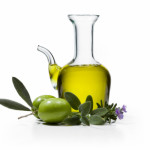 Good Fat, Bad Fat
Good Fat, Bad Fat
Dietary fat has such a bad reputation; it might as well be a four-letter word! No one wants to be fat, and we all know that eating too much fat isn’t good for us. It’s for reasons like these that I believe some people, on their way to a healthier lifestyle, may have thrown the proverbial baby out with the bath water when it comes to foods that contain fat—avoiding them at all costs.
Well, there is a great cost if you fail to eat enough fat in your diet. An adequate supply of fats (fatty acids or lipids) within the body are critical to the health of your cell membranes, your hormone production, the absorption and transportation of vitamins A, D, E and K, as well as the health of your hair and skin. Additionally, the presence of fat in the digestive system slows down the digestion process, allowing your body the time necessary to absorb all those vital nutrients.
The trick is knowing which fats are riding into your kitchen wearing white hats (good fats) and which are wearing black hats (bad fats). As a general rule of thumb, fats which are solid at room temperature are typically bad for you. These bad fats, which are also known as saturated fats, include such foodstuffs as butter, animal fats, dairy products, mayonnaise, and lard. Coconut oil is an exception to this “rule”. (See, this is why I hate rules!)
Good fats, which should of course be eaten in moderation, include cold water fish, eggs, olive oil, tree nuts, and, my personal favorite, avocados. These fat-containing foods are primarily mono- or poly-unsaturated fats are essential to maintaining a healthy mind and body.
Take care to eat only a small amount of bad fat and a variety of good-for-you-fats. Certainly if you eat too much of anything—good fat, bad fat, protein or carbohydrate, your body will store those excess calories as adipose tissue, or body fat…and that is the worst kind of fat of them all!